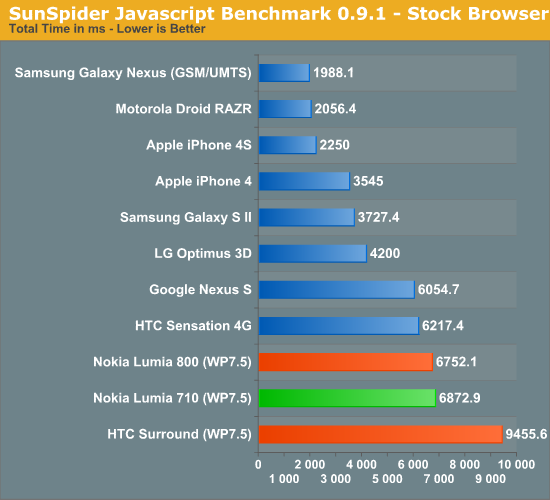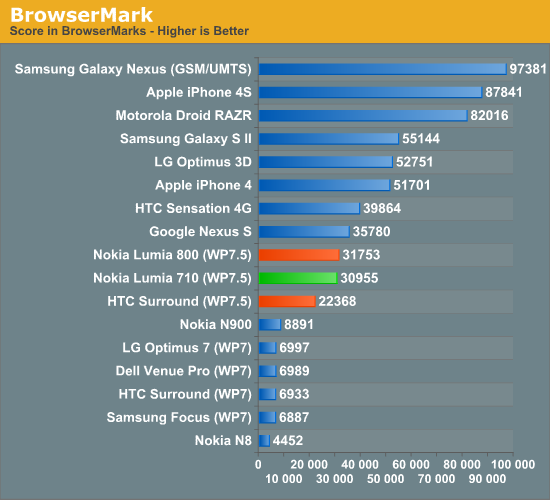Nokia Lumia 710 Review - T-Mobile's Nokia WP7
by Brian Klug on January 5, 2012 12:01 AM EST- Posted in
- Smartphones
- Nokia
- Mobile
- WP7
- Lumia 710
Performance
Unfortunately, the majority of benchmarks that usually grace our smartphone reviews don’t yet have WP7 ports or analogs, but there are a still a number of comparisons we can make. To start, the browser-based performance metrics give a good picture within the Windows Phone ecosystem, and likewise with WPbench, created by one of our own readers and on the marketplace.
This current refresh of WP7 devices continues to be based around exclusively Qualcomm SoCs, and the Lumia 710 is no exception. Both the 710 and 800 are based around Qualcomm’s MSM8255 single core S2 snapdragon at 1.4 GHz with Adreno 205 graphics at the core and dual channel LPDDR2 memory interfaces. This is a 45nm part we’ve seen and explored numerous times before, and as a refresher includes the HSPA+ 14.4 baseband onboard. At this point, there really only are three different SoC and clock configurations which WP7 has to deal with - 1.0 GHz QSD8x50 Snapdragon (65nm single core with Adreno 200 graphics), 800 MHz - 1.0 GHz MSM8x55/MSM7x30 Snapdragon (45nm single core with Adreno 205 graphics), and now a higher clocked 1.4 GHz MSM8x55 Snapdragon.
Those three configurations essentially tell the complete story of Windows Phone’s SoC evolution since launch, which are clearly outlined in their chassis requirements. I spent a paragraph in the Lumia 800 talking about why benchmarking will become even more important in the Windows Phone 7 / Windows 8 ecosystem as this opens up to more SoCs (and ST-E per Nokia’s influence), and how a huge number of benchmark players are busily porting the same Android/iOS benchmarks to the platform. Eventually WP7 will make the jump to dual-core as well.
Anyhow, onward to the numbers. First is sunspider, which we’ve been using for a long while and recently changed from 0.9 to 0.9.1 with. As a result, I’ve had to re-run devices since the numbers aren’t directly comparable. WP7.5 brings a much improved javascript engine which gives it a big boost in scores. I’ve managed to hang onto the HTC Surround (1.0 GHz QSD8250) which we’ve included as well.

I sound like I’m on repeat, but unsurprisingly we see the same performance we did out of the Lumia 800 (again both are using 1.4 GHz MSM8255) and a big jump thanks to running WP7.5. The new combination of IE9’s Trident 5.0 and Chakra JavaScript JIT engine also helps narrow the gap between iOS and Android in the JavaScript department. Obviously it can’t come close to matching the phones up there with dual core SoCs, however.
Browsermark hasn’t changed or forced us to re-run things, so we have comparison numbers from WP7 devices pre-update that show how much difference there is in the browser department in WP7.5.

Again here things are almost exactly on par with the Lumia 800, unsurprisingly. Unfortunately if you use the Nexus S (1.0 GHz S5PC110 “Hummingbird” with a Cortex A8 CPU) as a comparison point (vs the 1.4 GHz Scorpion inside MSM8255) you can see how the WP7 team needs to eek some more performance out to bring things totally up to parity. I should note that Nexus S number is for 2.3.6 as well, 4.0.3 puts things even further out of reach.
For system benchmarking on WP7.5 we have WPBench, which was created by one of our own readers. The benchmark reports a total score in addition to three sub-scores for CPU, memory, and GPU.
| WPBench Comparison | |||
| HTC Surround (1.0 GHz QSD8250) | Nokia Lumia 800 (1.4 GHz MSM8255) | Nokia Lumia 710 (1.4 GHz MSM8255) | |
| Total Score | 61.58 | 91.14 | 92.85 |
| Result Screenshot |
 |
 |
|
The rest of WP7.5’s UI in first party applications and the main navigation areas is very smooth, admittedly. It’s here that you really see the reasoning for many people arguing that WP7.5 doesn’t need to make the jump to dual-core very soon. Silverlight applications can occasionally stutter, however, it’s hard to fully codify the differences between first-party (native code) and third-party (Silverlight) performance until we get better tools.












48 Comments
View All Comments
augustofretes - Monday, January 9, 2012 - link
You lied to us :( XDKTGiang - Thursday, January 5, 2012 - link
The Nokia Luma710 isn't the "midrange" product for Nokia. The 800 is the "midrange" product and they haven't announced their high end product for the US yet. I do agree that Nokia doesn't make too much sense right now but at the same time I don't exactly own a successful phone manufacturing company.Brian Klug - Thursday, January 5, 2012 - link
That's true, I guess I should state that at present those labels are relative - only the 710 and 800 are announced. (Though we'll see what happens at CES...)-Brian
KTGiang - Thursday, January 5, 2012 - link
Yup, you did some good editing for better accuracy. Only people who are up on their Windows Phones news knows that Nokia actually gave a statement saying they didn't release the Lumia 800 in the US because they wanted to make sure they released a proper high end phone to compete in the market over here. Also, they wanted to establish a base and buzz in the rest of the world with the Lumia 800 where they still have phones in the hands of their consumers.name99 - Thursday, January 5, 2012 - link
You get judged by what you SHIP not by what you plan one day to ship.You know what's a truly awesome phone, way better than ALL this crap Anand is talking about --- the iPhone 7! Man, that thing makes a Lumia 710 look like a Nokia 6235 candybar.
jjj - Thursday, January 5, 2012 - link
In the US it's all about the high end,the consumer is quite a different beast from most other places and to be fair the price difference is pretty small.Why T-Mo and the 710? Nokia most likely has better relations with T-Mo than with the other US carriers so it was easier to bring the device to market fast and they didn't wanted to give a higeher end device to the smallest of the big 4 or maybe nobody was interesting in heavily subsidizing the 800.As for the device itself i'm not sure it's a better buy than the HTC Radar 4G.
For the ecosystem,it's hard to have faith in Microsoft,they are slow and afraid to innovate,the Windows brand doesn't have the best image and the first steps towards an OS unification are not great.Win 8 might be Vista 2 for traditional PC users.If they don't let us disable the Metro UI on desktops, i know i won't upgrade to Win8,don't need the extra bloat. They'll keep trying to buy their way in,just like they are doing with Bing ( terrible search engine BTW and i use it often) but they need to do better to actually succeed.
dagamer34 - Thursday, January 5, 2012 - link
Afraid to innovate? Have you SEEN Windows 8??jjj - Thursday, January 5, 2012 - link
have you,or you just have a vague idea about what it is?Nataku - Thursday, January 5, 2012 - link
u really just sound like u have a grudge towards microsoft now... i've used the dev preview, i admit its not that great for keyboard/mouse use but definitely works wonders once you get touch screen, but thats only the dev preview and ms said they would do something about it (otoh, the new task manager is great)now about innovation, xbox was definitely innovative, wp7/zune dont get enough credit they are some of the the most innovative product as well, sky drive is fantastic now with the new update and fix they have in place (still hate the 100mb file limit though...)
Microsoft isn't the monstrosity it used to be, they actually listen to customers now and do things right, give them another chance
Samus - Thursday, January 5, 2012 - link
still a shame the Venue Pro is the ONLY WP7 with a keyboard...